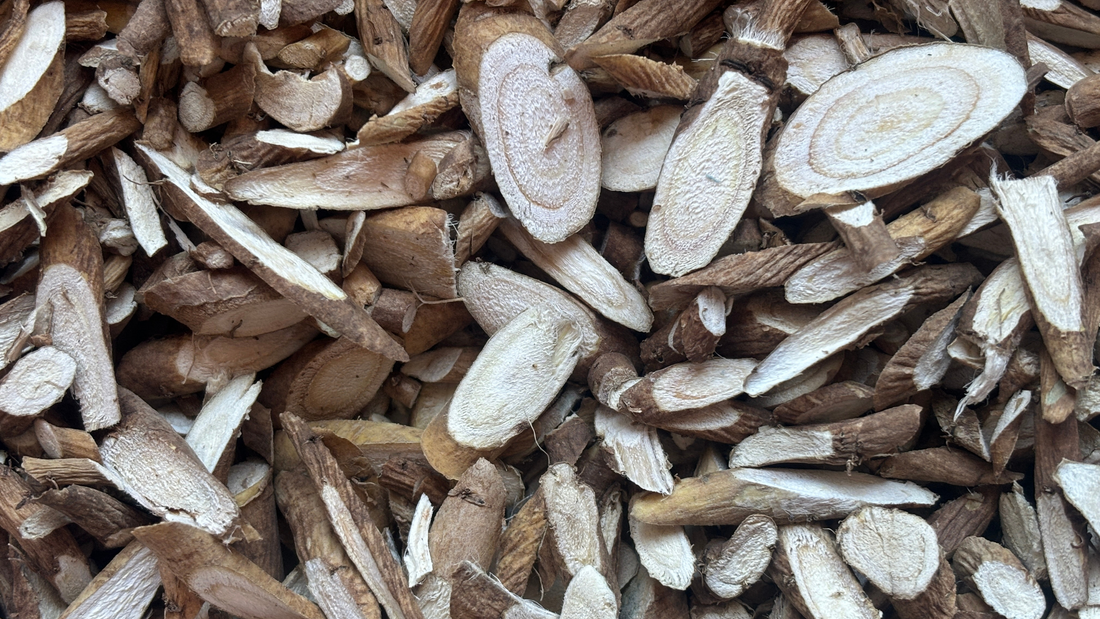
First Marshmallow Harvest
Share
Fun topics below: marshmallow harvesting, medicine past & present, wacky Roman writings, mucilage, marshmallow confections
Nature is always a lesson in patience. A sowing in the spring for harvest in the autumn is one of the few things in this era of convenience that allows me to experience delayed gratification. I’m accustomed to 3-6-9 month wait times, but 3 years?!? That’s how long I’ve waited to finally harvest my marshmallow (Althea officinalis) root in the garden. Maybe it’s been 4 years at this point - can’t even remember. A few growing seasons (2-4 years) are needed to bulk up the roots. The roots are large, slightly firm, and supple. They should be the color of parsnips, but the skins of mine are stained with red clay. No amount of scrubbing helps. That’s ok I guess, but I’ve learned my lesson. Loose, rich soil will mean less scrubbing and easier digging in the future.

During the past few years I’ve enjoyed this perennial mallow. I loved watching it come up from the ground every spring, grow fast to the sky, and put out pretty flowers reminiscent of hibiscus (hibiscus and marshmallow are in the same plant family, Malvaceae, along with okra, chocolate, and linden). However, I must admit I’m not too sad to rip them out and start over. We had a very wet spring and a very dry late summer this year, and the marshmallows seemed stressed. They have a tendency to develop rust, which is usually not fatal but unsightly. This also affects the marshmallows in the nursery. We grew some this year to add to our inventory, but they never looked great. Almost everything we grow is overhead watered, and that’s a no-go for the marshmallows. I’d like to continue troubleshooting it, though. Marshmallow is a much-loved plant amongst herbalists and gardeners, and so it would make sense to offer it at some point. [UPDATE 2024: Marshmallow 'Erfurter' available now! Yay!]
One of the reasons marshmallow is a cornerstone medicinal plant is because it treats a myriad of physical problems but is very gentle. There’s little worry when it comes to dosing - be it an infusion, tincture, or capsule. I’m a faint-hearted herbalist and forager myself. The genus Althea comes from the Greek word altho, which means “to cure.” And that’s an apt moniker. Marshmallow has been used for centuries to cure things. It was even described in an herbal text dating back to the 2nd century BC! Ancient Chinese, Syrians, and Romans all used marshmallow for medicine and food. As a vegetable, it was considered a delicacy by the Romans.

Speaking of the Romans, I just spent the last hour reading my translated copy of Pliny’s Natural History to see what he had to say about marshmallow, and boy, is it an interesting ride. Each sentence is like cognitive whiplash. One sentence reads: “the seed taken in dark wine clears away phlegm and nausea.” I can get on board with that. But the next sentence reads: “the root attached as an amulet in dark wool stays troubles of the breast”...ok, major side eye there. And then the next sentence seems reasonable again: “boiled in milk and taken like broth it relieves a cough in five days.” I love reading old herbals such as this because it is all at once a mixture of proven fact and hokey superstition. Long gone are the days when scientific literature read like spellbooks.

More interesting excerpts...
“They are efficacious against every sort of stings, especially those of scorpions, wasps, and similar creatures, and those of the shrew-mouse”
“Whoever swallows daily half a cyathus of the juice of any one of them [mallows] will be immune to all diseases”
“Running sores on the head are cured by mallows that have rotted in urine...dandruff and loose teeth by a decoction of the root”
Yet for all the crazy sounding claims, marshmallow really does hold its own as a “cure-all.” The unique thing about marshmallow is its mucilage. If you’ve handled marshmallow before, then you know what I’m talking about. If not, then have you handled or eaten okra? Or maybe chia seeds? You know how it gets all slimy? That is mucilage. It is produced copiously in some plants like marshmallow and okra. Mucilage is a water-soluble polysaccharide produced in large specialized cells. If I tear apart a marshmallow flower or leaf, I can immediately feel the mucilage between my fingers. The roots house even more. It’s this substance which is so soothing to the body, both internally and externally.
Think of any time you’ve had a cold or dry cough - maybe an ulcer or urinary tract infection. How irritated, inflamed, scratchy, red, and/or uncomfortable it feels. Like aloe for a burn, marshmallow soothes the affected area and takes up the slack for the mucous membranes…Do I have a lot of personal experience with using marshmallow as a medicine? No. But I have used herbalist Richo Cech’s formula for UTIs (goldenrod, juniper, & marshmallow), and it works really well. Anything that circumvents the need for an antibiotic is a holy grail solution in my eyes.

Now that I have my own dried marshmallow root, I’m happy to have it on hand. I’ll have to learn how to best extract the mucilage from the roots. It’s not as simple as boiled water and a quick steep. The mucilage is delicate and must be extracted over a period of time in cool water (a cold infusion). Too much heat denatures the proteins and reduces the viscosity. If a flu or infection doesn’t happen to one of us soon - knock on wood that it doesn’t - then I might try using it on my face to see if it amps up my skin care routine. Or maybe I’ll make marshmallows, the confection! Yes, if you were wondering; the fluffy, white, sweet pillows we call marshmallows today were originally made with marshmallow root. But I’ll save that delicious rabbithole for another time.
